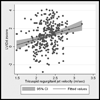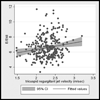Prospective echocardiography assessment of pulmonary hypertension and its potential etiologies in children with sickle cell disease
- PMID: 19699350
- PMCID: PMC3197734
- DOI: 10.1016/j.amjcard.2009.04.034
Prospective echocardiography assessment of pulmonary hypertension and its potential etiologies in children with sickle cell disease
Abstract
Pulmonary hypertension (PH) is associated with adverse outcomes in adults with sickle-cell disease (SCD), but its importance in children is less clear. The aim of this study was to define the incidence and causes of PH in pediatric patients with SCD. Children with SCD (n = 310) and matched controls (n = 54) were prospectively enrolled under basal conditions. Participants underwent echocardiography, pulse oximetry, 6-minute walk tests, and hematologic testing. Echocardiographic measures were compared between patients with SCD and control subjects before and after adjusting for hemoglobin. Correlations of echocardiographic and clinical parameters were determined. Tricuspid regurgitation velocity (TRV) was elevated compared to controls (2.28 vs 2.10 m/s, p <0.0001). Increased TRV was associated with left ventricular diastolic diameter, hemoglobin, and estimated left atrial pressure. TRV remained elevated when controlling for left ventricular diameter and left atrial pressure. Echocardiographically derived pulmonary resistance was not significantly different between patients with SCD and controls, although it was elevated in the SCD subgroup with elevated TRV. When controlling for hemoglobin, TRV was no longer statistically different, but pulmonary insufficiency velocity, septal wall thickness, and estimated pulmonary resistance were statistically higher. TRV, pulmonary insufficiency end-diastolic velocity, and markers of increased cardiac output were correlated with indicators of adverse functional status, including history of acute chest syndrome, stroke, transfusions, and 6-minute walk distance. In conclusion, children with SCD had mildly increased TRV that was correlated with increased cardiac output and left ventricular filling pressures. Hemoglobin-adjusted analysis also suggested a contribution of primary vascular changes.
Conflict of interest statement
Disclosures: Victor Gordeuk, MD - Grants from Biomarin and Actelion pharmaceutical companies and Consulting for Ikaria Pharmaceutical Company; Other Authors – No disclosures/conflict of interest
Figures





Similar articles
-
Cardiomyopathy With Restrictive Physiology in Sickle Cell Disease.JACC Cardiovasc Imaging. 2016 Mar;9(3):243-52. doi: 10.1016/j.jcmg.2015.05.013. Epub 2016 Feb 17. JACC Cardiovasc Imaging. 2016. PMID: 26897687 Free PMC article. Review.
-
Paediatric sickle cell disease: pulmonary hypertension but normal vascular resistance.Arch Dis Child. 2011 Feb;96(2):131-6. doi: 10.1136/adc.2010.184028. Epub 2010 Oct 27. Arch Dis Child. 2011. PMID: 21030373
-
Elevation of tricuspid regurgitant jet velocity, a marker for pulmonary hypertension in children with sickle cell disease.Pediatr Blood Cancer. 2006 Dec;47(7):907-13. doi: 10.1002/pbc.20791. Pediatr Blood Cancer. 2006. PMID: 16496290
-
Echocardiographic markers of elevated pulmonary pressure and left ventricular diastolic dysfunction are associated with exercise intolerance in adults and adolescents with homozygous sickle cell anemia in the United States and United Kingdom.Circulation. 2011 Sep 27;124(13):1452-60. doi: 10.1161/CIRCULATIONAHA.111.032920. Epub 2011 Sep 6. Circulation. 2011. PMID: 21900080 Free PMC article. Clinical Trial.
-
Pulmonary hypertension in sickle cell disease children under 10 years of age.Br J Haematol. 2010 Sep;150(5):601-9. doi: 10.1111/j.1365-2141.2010.08269.x. Epub 2010 Jun 10. Br J Haematol. 2010. PMID: 20553267 Review.
Cited by
-
Cardiovascular abnormalities in sickle cell disease.J Am Coll Cardiol. 2012 Mar 27;59(13):1123-33. doi: 10.1016/j.jacc.2011.10.900. J Am Coll Cardiol. 2012. PMID: 22440212 Free PMC article. Review.
-
Update on pulmonary hypertension 2009.Am J Respir Crit Care Med. 2010 May 15;181(10):1020-6. doi: 10.1164/rccm.201002-0235UP. Am J Respir Crit Care Med. 2010. PMID: 20460546 Free PMC article. Review. No abstract available.
-
Intravascular hemolysis and the pathophysiology of sickle cell disease.J Clin Invest. 2017 Mar 1;127(3):750-760. doi: 10.1172/JCI89741. Epub 2017 Mar 1. J Clin Invest. 2017. PMID: 28248201 Free PMC article. Review.
-
Hemodynamic characteristics and predictors of pulmonary hypertension in patients with sickle cell disease.Am J Cardiol. 2012 May 1;109(9):1353-7. doi: 10.1016/j.amjcard.2011.11.067. Epub 2012 Feb 15. Am J Cardiol. 2012. PMID: 22341923 Free PMC article.
-
The risks and benefits of long-term use of hydroxyurea in sickle cell anemia: A 17.5 year follow-up.Am J Hematol. 2010 Jun;85(6):403-8. doi: 10.1002/ajh.21699. Am J Hematol. 2010. PMID: 20513116 Free PMC article. Clinical Trial.
References
-
- ATS statement: guidelines for the six-minute walk test. Am J Respir Crit Care Med. 2002;166:111–117. - PubMed
-
- Lai WW, Geva T, Shirali GS, Frommelt PC, Humes RA, Brook MM, Pignatelli RH, Rychik J. Guidelines and standards for performance of a pediatric echocardiogram: a report from the Task Force of the Pediatric Council of the American Society of Echocardiography. J Am Soc Echocardiogr. 2006;19:1413–1430. - PubMed
-
- Pettersen MD, Du W, Skeens ME, Humes RA. Regression Equations for Calculation of Z Scores of Cardiac Structures in a Large Cohort of Healthy Infants, Children, and Adolescents: An Echocardiographic Study. J Am Soc Echocardiogr. 2008;21:922–934. - PubMed
-
- Lang RM, Bierig M, Devereux RB, Flachskampf FA, Foster E, Pellikka A, Picard MH, Roman MJ, Seward J, Shanewise JS, Solomon SD, Spencer KT, Sutton MS, Stewart WJ. Recommendations for chamber quantification: a report from the American Society of Echocardiography's Guidelines and Standards Committee and the Chamber Quantification Writing Group, developed in conjunction with the European Association of Echocardiography, a branch of the European Society of Cardiology. J Am Soc Echocardiogr. 2005;18:1440–1463. - PubMed
-
- Nosir YF, Vletter WB, Boersma E, Frowijn R, Ten Cate FJ, Fioretti P, Roelandt JR. The apical long-axis rather than the two-chamber view should be used in combination with the four-chamber view for accurate assessment of left ventricular volumes and function. Eur Heart J. 1997;18:1175–1185. - PubMed
Publication types
MeSH terms
Grants and funding
LinkOut - more resources
Full Text Sources
Medical
Molecular Biology Databases

